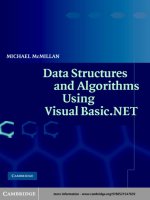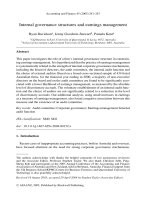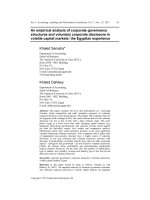Basic sentence structures and patterns updated
Bạn đang xem bản rút gọn của tài liệu. Xem và tải ngay bản đầy đủ của tài liệu tại đây (108.88 KB, 3 trang )
Basic Sentence Structures and Patterns
7 basic sentence patterns in English
•
•
•
•
•
•
•
S-V
S-V-O
S-V-A
S-V-O-A
S-V-O-O
S-V-C
S-V-O-C
1. Subject – Verb
There are 2 main elements of a sentence: Subject and Verb
Examples:
It is raining.
The chickens are eating.
The child is sleeping.
2. Subject – Transitive Verb [Ngoại Động Từ] – Object
In this pattern, an object is required after the verb. The Object can be a Noun, Noun Phrase,
Pronoun, Gerund (V-ing) and That- Clause
- Ngoại động từ là động từ bắt buộc phải có tân ngữ theo sau. Tân ngữ theo sau ngoại động từ có
thể là danh từ, cụm danh từ, đại từ, danh động từ hoặc mệnh đề That.
Examples:
The dog is chasing the mouse.
S
V
O (Noun Phrase)
They are finishing writing the report.
S
V
O (Gerund)
The sales report shows that our company is going bankrupt.
S
V
O (That – Clause)
The sales figures are incorrect. I am looking at them.
S
V
O (Pronouns)
3. Subject – Intransitive Verb [Nội Động Từ] – Adverb
Intransitive verbs are verbs that do not require any abject.
- Nội động từ là động từ không cần tân ngữ theo sau.
Adverbs can be of time, place, manner, prepositional phrase.
Examples:
The new employee works hard.
S
V
A (manner)
Profits increased steadily last year.
S
V
A (manner – time)
The children are playing in the garden.
S
V
A (place – prepositional phrase)
4. Subject – Transitive Verb – Object – Adverb
Examples:
The dog is chasing the little mouse in the garden.
S
V
O
A
Page 1 of 3
We were studying English in the library this time yesterday.
S
V
O
A
5. Subject – Di-transitive Verb – Indirect Object [Tân ngữ gián tiếp] – Direct Object [Tân ngữ trực
tiếp]
Di-transitive verbs require 2 objects: indirect object (people) and direct object (things)
Examples:
I will give an outstanding employee an award.
S
V
IO
DO
The store sent us a number of receipts.
S
V IO
DO
Notes: We can change the position of the direct and indirect objects.
(Vị trí của 2 tân ngữ có thể được đổi cho nhau, trong trường hợp này giới từ “TO” hoặc “FOR” phải
được sử dụng giữa 2 tân ngữ.)
I will give an award to
an outstanding employee.
DO + preposition +
IO
The store sent a number of receipts to us.
The teacher taught British and American cultures to us.
Some di-transitive verbs are: bring, tell, send, show, teach, promise, buy, throw, write, sell, owe,
grant, allow, feed, pass, read, take, offer, give, pay, lend, etc
6. Subject – Linking Verb – Complement
Linking verbs: be, get, become, keep, remain, look, sound, seem = appear, feel, find, etc
Complement: Adjective, Noun Phrase
In this pattern, the adjective describes the state of the subject or the noun phrase gives additional
information / explanation about the subject.
Examples:
The serious problem was difficult to solve.
S
V
C (adjective)
The company’s products remain competitive.
S
V
C (adjective)
The famous speaker is our supervisor.
S
V
C (noun phrase)
7. Subject – Transitive Verb – Object – Complement
This pattern contains an object complement, which modifies the object and comes after it.
Object complement can be an adjective or a noun / noun phrase.
Examples:
Last month’s bonuses made me happy.
S
V O
C (adjective)
We chose Mary our group leader.
S
V
O
C (noun phrase)
Page 2 of 3
Page 3 of 3









